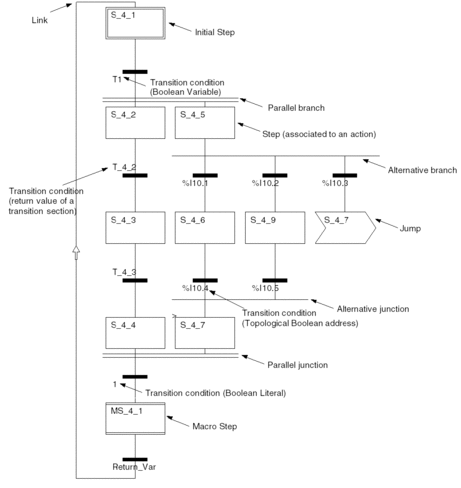Introduction
The sequence language SFC (Sequential Function Chart), which conforms to IEC 61131-3, is described in this section.
Structure of a Sequence Controller
IEC conforming sequential control is created in Control Expert from SFC sections (top level), transition sections and action sections.
These SFC sections are only allowed in the Master Task of the project. SFC sections cannot be used in other tasks or DFBs.
In Single Token, each SFC section contains exactly one SFC network (sequence).
In Multi-Token, an SFC section can contain one or more independent SFC networks.
Objects
An SFC section provides the following objects for creating a program:
Comments regarding the section logic can be provided using text objects (related topics Text Object).
Representation of an SFC Section
Appearance:

Structure of an SFC Section
An SFC section is a "Status Machine", i.e. the status is created by the active step and the transitions pass on the switch/change behavior. Steps and transitions are linked to one another through directional links. Two steps can never be directly linked and must always be separated by a transition. The active signal status processes take place along the directional links and are triggered by switching a transition. The direction of the chain process follows the directional links and runs from the end of the preceding step to the top of the next step. Branches are processed from left to right.
Every step has zero or more actions. A transition condition is necessary for every transition.
The last transition in the chain is always connected to another step in the chain (via a graphic link or jump symbol) to create a closed loop. Step chains are therefore processed cyclically.
SFCCHART_STATE Variable
When an
SFC section is created, it is automatically assigned a variable of
data type SFCCHART_STATE. The variable that is created
always has the name of the respective SFC section.
This variable is used to assign the SFC control blocks to the SFC section to be controlled.
Token Rule
The behavior of an SFC network is greatly affected by the number of tokens selected, i.e. the number of active steps.
Explicit behavior is possible by using one token (single token). (Parallel branches each with an active token [step] per branch as a single token). This corresponds to a step chain as defined in IEC 61131-3).
A step chain with a number of maximum active steps (Multi Token) defined by the user increases the degree of freedom. This reduces/eliminates the restrictions for enforcing unambiguousness and non-blocking and must be guaranteed by the user. Step chains with Multi Token do not conform to IEC 61131-3.
Section Size
An SFC section consists of a single-page window.
Because of performance reasons, it is strongly recommended to create less than 100 SFC sections in a project (macro section are not counted).
The window has a logical grid of 200 lines and 32 columns.
Steps, transitions and jumps each require a cell.
Branches and links do not require their own cells, they are inserted in the respective step or transition cell.
A maximum of 1024 steps can be placed per SFC section (including all their macro sections).
A maximum of 100 steps can be active (Multi Token) per SFC section (including all their macro sections) .
A maximum of 64 steps can be set manually at the same time per SFC section (Multi Token).
A maximum of 20 actions can be assigned to each SFC step.
The nesting depth of macros, i.e. macro steps within macro steps, is to 8 levels.
IEC Conformity
For a description of the extent to which the SFC programming language conforms to IEC, see IEC Conformity.


